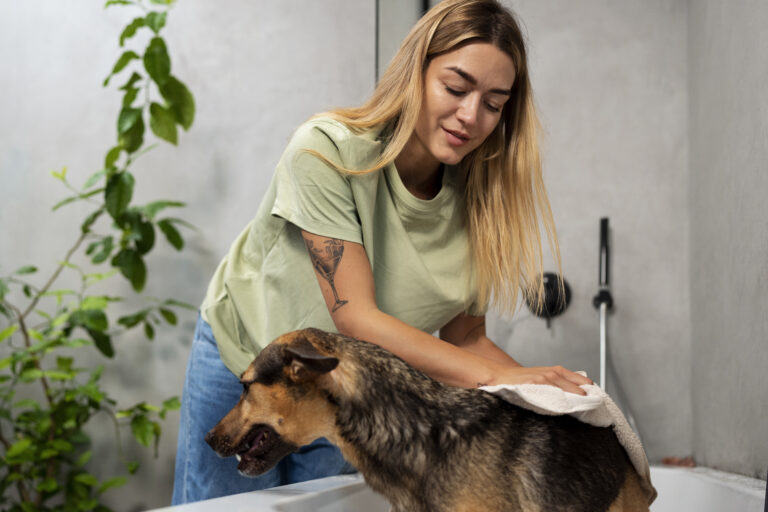As a fur mom, bathing your fur babies can be a delightful bonding experience, but it requires a gentle touch, patience, and some know-how to make it enjoyable for you and your pets. While cats are known for their self-grooming prowess, and some dogs revel in rolling around in mud puddles, regular baths are essential to keep your fur babies clean and healthy. Here are some steps you should follow to be a successful fur mom to your fur babies.
Pre-Bath Preparations: Setting the Stage for Success
Before you even fill the tub, preparing your pet and the bathing environment is essential. Brush your pet’s coat thoroughly to remove loose fur and mats or tangles. This helps in the cleaning process and prevents fur from clogging the drain.
One of the causes of matting in your fur babies is allergies. To prevent further matting, you need to check their diet closely. If they are allergic to, for example, grain, you might want to buy grain free dog food in the future. Additionally, check your pet’s ears for any signs of infection or wax buildup and trim their nails if needed.
Choose a mild, pet-friendly shampoo suitable for your pet’s specific coat type and any skin conditions they may have. Fill the tub with a few inches of lukewarm water, ensuring it’s not too hot or cold. Gather towels, a non-slip mat for the tub, and treats for positive reinforcement.
Creating a Positive Environment: Turn Bath Time into Play Time
Pets can be sensitive to changes in their routine, and the sight of a bathtub may trigger anxiety in some. Introduce your pet to the bathroom without immediately jumping into the bath process to create a positive association with bath time. Let them explore the space, offer treats, and, if possible, incorporate playtime in the bathroom.
Consider placing a non-slip mat in the tub to stabilize your pet. Cats, in particular, may benefit from a small, shallow basin instead of a full-sized tub. Gradually acclimate your pet to the water by allowing them to touch it with their paws and rewarding them for positive behavior.
Preventing Water Stress: Gentle Introduction to Wetting
Once your pet is comfortable in the bathing area, begin wetting. Use a handheld sprayer or a cup to wet your pet gradually. Start from the back and work to the head, avoiding the face for now. Speak to your pet calmly soothingly, and offer treats as positive reinforcement. Keep the water pressure low to minimize stress, and always be mindful of your pet’s body language.
Cats may require a different approach, as they are generally not fans of water. Consider using a damp cloth to wipe them down, or explore waterless cat shampoos for a less intrusive cleaning experience.
Shampooing Techniques: Lathering Up with Care
Choosing the right shampoo is crucial for a successful bath. Consult your veterinarian if your pet has specific skin conditions or allergies. Once you have the appropriate shampoo, apply it in small amounts, starting from the top to the bottom. Carefully massage the shampoo into the fur, focusing on areas prone to matting, such as the neck and behind the ears.
Consider diluting the shampoo for dogs with long coats to ensure it reaches the skin and leaves no residue. Take extra care around sensitive areas like the eyes, ears, and genital area. You can then wash them thoroughly to remove all traces of shampoo, as residue can irritate the skin.
Conditioning for Extra Softness: Pampering Your Pet’s Coat
Conditioning is optional but beneficial, especially for pets with longer hair or dry skin. Choose a conditioner formulated for pets, as human products may contain ingredients that can be harmful to them. Apply the conditioner after shampooing, focusing on the tips of the hair to prevent a greasy feel.
Allow the conditioner to sit for the recommended time, usually a few minutes, and then rinse thoroughly. Conditioning not only adds softness and shine to the coat but also helps in detangling, making brushing after the bath smoother.
Drying Techniques: Towel Time and Beyond
After the bath, the drying process requires patience and gentle handling. Use absorbent towels to remove excess water from your pet’s coat. Avoid vigorous rubbing, especially for long-haired breeds, to prevent matting. A blow dryer on a low heat setting can speed up the drying process for dogs that tolerate it.
Ensure the noise and sensation of the dryer don’t distress your pet. Cats may prefer air-drying, and providing a warm, draft-free space to groom themselves can be sufficient. Ensure your pet is completely dry before allowing them to go outside, especially in cooler weather.
Positive Reinforcement: Ending on a Happy Note
End the bathing experience on a positive note by offering treats, praise, and playtime. This reinforces that bath time is not a punishment but an opportunity for pampering and attention. Keeping the experience positive contributes to a cooperative attitude in future bathing sessions.
Remember that some pets may adjust to baths, and patience is key. If your pet is exceptionally stressed during baths, consider seeking the guidance of a professional groomer or a veterinary behaviorist.
Conclusion
As a fur mom, bathing your fur babies can be a rewarding experience when approached with care, patience, and a positive mindset. The process keeps your fur babies clean and healthy and strengthens the bond between you and your furry companions.
Creating a positive environment, introducing water gradually, using the right products, and practicing gentle techniques can turn bath time into a joyful ritual that both you and your pets look forward to. Roll up your sleeves, grab those towels, and let the splashing begin – a clean and content fur baby awaits on the other side.
Image by Freepik



